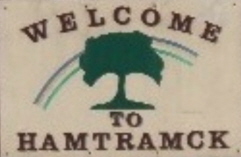November 13, 2007, - 1:14 pm
Hamtramckstan: Detroit Suburb Says “Erase Polish Heritage ‘Cuz We Are Muslim”
By Debbie Schlussel
Readers of this site are familiar with Hamtramck, Michigan. I’ve written plenty over the last several years about this city surrounded on all borders by Detroit. It was a city of Polish Catholics, and my Polish great-great-uncle Chaim had shoe stores there at the turn of the century (that century).
Now, as I’ve repeatedly written, it has been taken over by Muslims mostly from Yemen and Bangladesh and encountered the extremism, religious intolerance, and violence that Islam often brings when it reaches critical mass in a Western setting.
Today’s Detroit Newsistan his an interesting, but not surprising, story about how Hamtramck is erasing cultural symbols and icons of its Polish heritage at the insistence of Muslims. A cafe that close up shop featured murals of Polish history and culture. The city bought them with an eye to putting them in a future museum of the city’s history. But that’s not what Muslims want, nor even the current Polish mayor of the town, Karen Majewski:


The recent closure of a longtime city landmark, the Holbrook Cafe, has prompted city officials to snap up the iconic restaurant’s murals of Polish history — and inadvertently sparked a debate about how the diverse city should remember its history.
City officials were among those who bought the colorful murals of Polish dancers, icons and composers with an eye toward incorporating them into a future museum about the city’s history.
But the one-time Polish stronghold now teems with those who trace roots to the Middle East, Africa and Bangladesh. As the pieces wait in storage while officials mull their fate, discussion is surfacing about how many of the images would be appropriate for a museum that’s in the works.
“Hamtramck is really conscious and really protective of its history,” said Mayor Karen Majewski, who, with a city resident, paid $80 in an auction at the cafe last month to take possession of about 16 of the indoor murals. “The murals are really priceless.”
The cafe, known to generations as a hot spot for wedding receptions and live music, featured a large mural outside tracing the history of Poland.
“Anything Polish in there (the museum) has to have a specific Hamtramck connection,” Majewski said. “We have to make sure all the city’s ethnic groups are represented. Our history is being made today as we change the full range of history and cultural life should be represented.”
Hamtramck is long remembered for its influx of Polish immigrants in the early 1900s when thousands flocked to the 2.2-square-mile city for jobs at the now-closed Dodge Main plant.
The population soared from 3,500 to more than 48,000 from 1910 to 1920, said Greg Kowalski, chairman of the city’s Historical Commission. Its population has since declined to about 23,000, and Kowalski said about 23 percent of residents are Polish. [DS: Greg Kowalski is also an editor and reporter for a local rag newspaper and covered my 1998 race for the Michigan House. He’s an uber-liberal, a creep, and a liar. If his skills as a “historian” are anything like those of his as a “reporter,” he simply isn’t one.]
Now, nearly 30 languages are spoken in the city’s schools with ethnic groups ranging from African-American to Bangladeshi, Indian, Bosnian, Russian, Arab, German and Mexican.
But as times change, the Polish influence in the city should be remembered, said Chris Cornwell, 37, a resident. He said the cafe’s 4-foot-wide by 8-foot-tall panels depicting Polish philosophers and leaders help preserve the memory of his ancestors who once comprised 99 percent of the city.
“For a period of Hamtramck’s existence, the Polish culture was extremely defining,” said Cornwell, a lifelong resident. “This was a town made famous by Poles. This can be seen as the end of a cultural era for Hamtramck as it transitions into its next form.”
But Bengali resident Shahab Ahmed said factoring Muslims and other groups into the historical equation is increasingly important today.
“When you go to a city museum you look for your own history. I’d like to see when Bengalis came to their power and moved in and Arabs and also African-Americans,” said Ahmed, who was elected in 2003 to Hamtramck’s City Council as the first Asian immigrant and Muslim.
“That will make people excited to visit more.”
And people wonder why I call it Hamtramckstan. A rose is a rose.
Coming in a generation or two to your city. Americastan is almost here. And in some places, it’s already a foregone conclusion.
Tags: Africa, Bangladesh, Chaim, Chairman, Chris Cornwell, Debbie Schlussel Readers, Detroit, Dodge Main plant, editor and reporter, Greg Kowalski, Hamtramck, Hamtramck's City Council, historian, Historical Commission, Holbrook Cafe, Karen Majewski, Mayor, Michigan, Michigan House, Middle East, Poland, Polish stronghold, reporter, Shahab Ahmed, USD, Yemen


Standard islamic MO. Nothing to be surprised about.
Witch-king of Angmar on November 13, 2007 at 2:21 pm